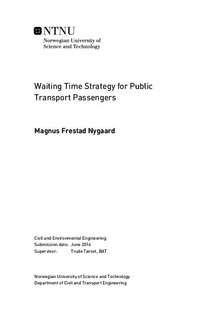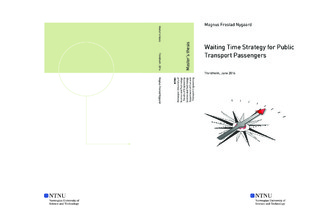| dc.description.abstract | Large population growth in cities and environmental concerns across the world puts
increasingly higher demands on public passenger transport. In several European cities,
including the nine largest urban areas in Norway (Samferdselsdepartementet, 2012) the
number of public transport trips is required to increase, with the overall goal of reducing the number of car trips. To overcome the challenges and to reach the goals, it is crucial that the transport models provides a better approximation of the real travel costs for public transport trips. In low-frequency public transport services, which occurs in most Norwegian cities, it is reasons to believe that the waiting time used in the transport models is much higher than what the passengers experience in real life.
Through the use of field studies and surveys, the study s aim to reveal the actual
waiting time that passengers experiences, plus revealing the passengers waiting time
strategy, and if, or how they are planning their time of arrival to the bus stop. It is interesting to see how the arrival distribution deviate from random and uniform distribution (which is used in the transport models), and how this varies with different headways. By revealing how passengers deals with the waiting time, it will be possible to discuss how waiting time should be dealt with in the transport models, in a way that gives better approximations of the travel costs of public transport trips in low-frequency services.
The waiting time of 1145 passengers were registered on 24 different bus stops in
Trondheim. The registrations were conducted manually with use of a self-designed
computing-program, which stored the exact time of the passengers arrivals and the buses departures. In addition, 109 public transport passengers answered a survey. The surveys goal was to investigate specific parts of the passengers waiting time strategies.
Results from this study show that the arrival distribution is far from uniform at 10-, 15-, and 20-minute headways. Most of the passengers plan their arrival to the bus stop based on the bus departure time, in order to minimize their waiting time. This indicates that the waiting time used in the transport models is larger than the waiting time the passengers experiences in real life. What waiting time strategy used, particularly according to how they plan their arrival time to the platform is of great relevance. Dividing the passengers into three different groups depending on their waiting time strategy is a good beginning on how to better model
the waiting time. The three groups is 1) random arrivals, 2) arrivals based on the timetable, 3) arrivals based on real time travel information. | |

